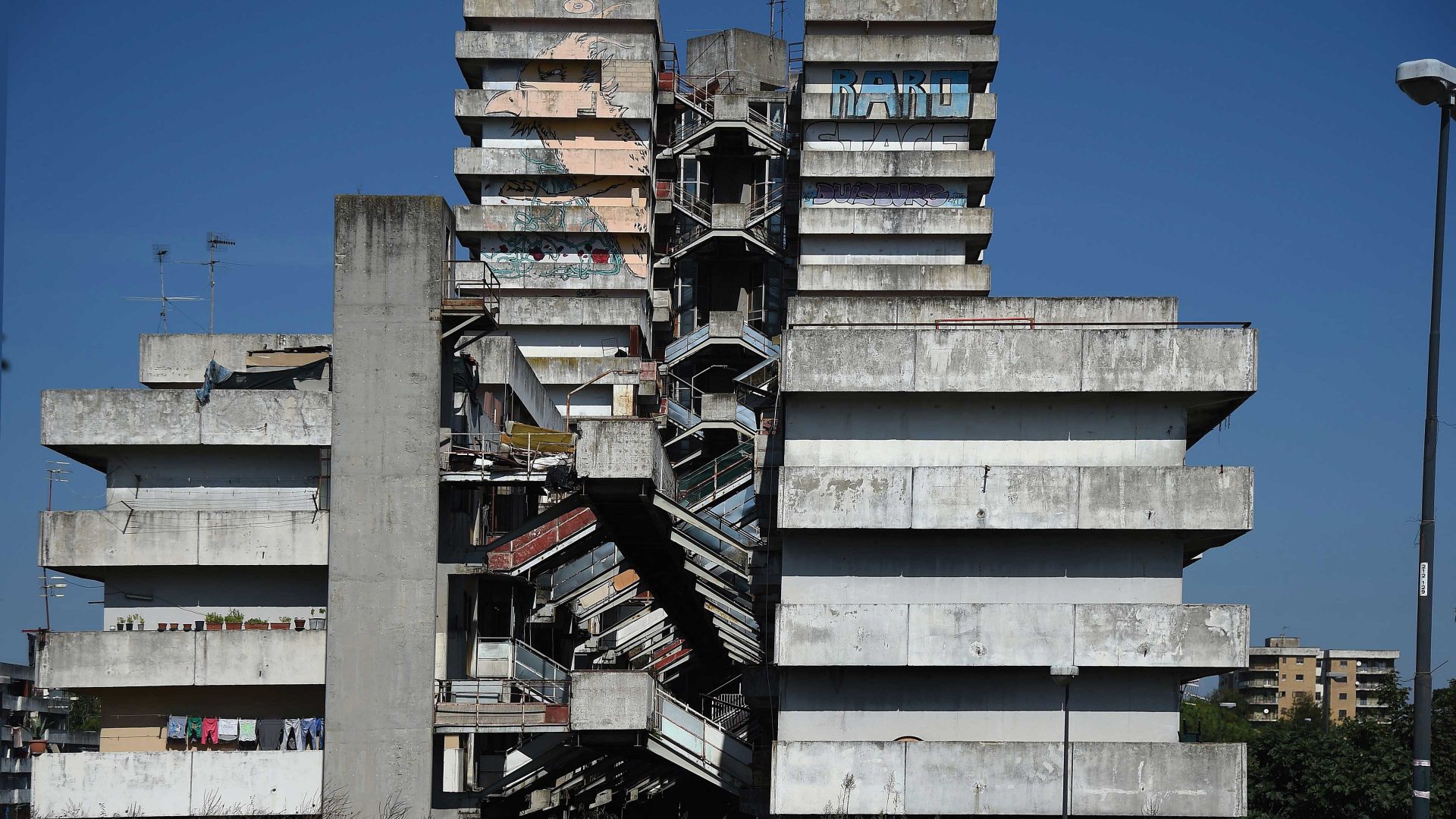Sitting beside the sun-dappled Mediterranean, in the smouldering shadow of Vesuvius, is Naples. It is the third largest city in Italy, the historic capital of the south and is known as the “paradise inhabited by devils”. The reason is the extreme contrast between the beauty of its historic architecture and the squalor found in its slums.
Naples suffered heavy allied bombing during the second world war, leaving many people homeless, a problem compounded by mass migration to the cities during Italy’s economic boom of the 1950s and 60s. Part of the solution to this housing crisis was a programme of municipal home building, and this included the construction of a series of apartment blocks known as Le Vele. Designed by Francesco (Franz) Di Salvo, and built between 1962 and 1975 in the northern Neapolitan suburb of Scampia, the buildings were influenced by the work of the French modernist Le Corbusier. Di Salvo was a brilliant architect but was influenced by the era’s penchant for “subsistence dwelling”.
Architects and urban planners saw the construction of tower blocks as an act of social responsibility. They offered a cost-effective way of rehousing people, of creating safe, decent housing, redolent of the new postwar Italy.
Di Salvo’s plans included eight brutalist buildings in two lots, named “M” and “L”, which between them took up 1.5 square miles. Flats in Le Vele were small, with just three to five rooms each. This minimal internal living area was to be supplemented by large walkways and shared, exterior spaces that were intended to evoke Naples’s baroque courtyards, medieval back streets
and alleyways. Open balconies would foster a sense of community.
“They were the emblem of a utopian style of architecture based on collective housing, decentralisation from the city centre and gigantism,” says Carmine
Piscopo, a professor in architecture and urban design at the University of Naples Federico II.
However, the buildings at Le Vele (it means “the sails”) soon took on a very different identity, as the TV crime series Gomorrah showed. The clean, modernist blocks of the architect’s imagination became degraded into a series of monstrous concrete housing blocks. Their decline, which was due to a combination of poverty, crime and bad luck, became symbolic of the
failure of Italy’s postwar housing policy. It also showed up the country’s wider social problems, including the lawlessness of the Camorra, Naples’s local mafia.
From the start, Le Vele was a magnet for corruption – money was siphoned away from the budget and corners were cut. The ensuing financial constraints meant that an eighth block was never built, leading to more people being crammed in the other seven and the size of the apartments and internal walkways being reduced. So tightly packed did they become, some residents were left with virtually no natural light. Walkways were built in concrete, not transparent material, which darkened the interiors even more.
“Di Salvo was revolutionary and avant-garde,” says Piscopo. “However, his good intentions were fatally betrayed.” In the end, the flats in the huge, cramped concrete buildings were nothing but “alienating containers”.
Many of the flats were not even finished and the first residents found themselves in homes that lacked basic facilities such as toilets, gas and electricity. The only running water was that which poured down the walls when it rained.
Worse, the surrounding neighbourhood offered no infrastructure. There were no schools, nurseries, gyms or cinemas. There was no marketplace. It was not until 1987 that a police station was opened – Naples has a higher ratio of police to residents than any other
city in Italy.
The open spaces between the buildings, intended as garden areas, quickly became rubbish dumps littered with leftover building materials and, increasingly, discarded syringes and other drug paraphernalia. The proposed public transport links were never created. In a grim irony, an area surrounded by main roads found itself cut off from the rest of the city.
The little remaining hope that the development would fulfil the utopian
dreams of the people who had designed and constructed it crumbled in November 1980, when southern Italy was rocked by the Irpinia earthquake. Lasting no more than a minute, the 6.9-magnitude quake killed 3,000 people and left more than 300,000 homeless. The destitute went to Le Vele and squatted in the apartments, many of which had been abandoned. The state turned a blind eye. The buildings, and the people within, were on their own.
Into this vacuum stepped the Camorra. Many of them were from Scampia. They understood the terrain of Le Vele. They knew how the labyrinthine elevated walkways could become rat runs in which the police could be easily evaded and how the open balconies could make ideal lookout posts.
In the 1980s, the unemployment rate in Naples topped 75%, which meant the Camorra had a willing workforce at its disposal. Soon Le Vele was awash with cocaine and heroin imported from South and Central America. Scampia became Europe’s most profitable drug market.
With drugs came violence, which erupted regularly between the ruling Di Lauro clan and the breakaway “secessionists”. The worst period came between 2004 and early 2005. At its peak, there was nearly a murder every day.
This brutal war was chronicled by Roberto Saviano in his book Gomorrah, which was turned into a hit TV show. Set in and around Le Vele, its brutal realism and engrossing, sustained plotline drew comparisons with some of the greatest crime TV series of them all, including The Sopranos and The
Wire.
The filming of Gomorrah brought some much-needed money to the area. The production company employed residents as extras and runners, and paid for vital building maintenance. However, there was a downside. Media crews from around the world descended on the area, bringing unwanted attention. Graffiti proclaiming “Non siamo Gomorra” (we are not Gomorrah), “Non siamo noi il problema” (we are not the problem) and “Le Vele non sono uno zoo” (Le Vele is not a zoo) was the pointed response.
According to Piscopo, the series presented the neighbourhood as “a stereotype from which to free itself. Scampia has a big heart. Right from
the start, people who lived in Le Vele set up committees and associations
denouncing the uninhabitable conditions in which they had to live.”
One such organisation, Il Comitato Vele, which was formed in the late 1980s, began the campaign for the buildings to be demolished, with better housing to be built in its place. It was only after one committee member, Vittorio
Passeggio, confronted the Italian president, Francesco Cossiga, outside the Royal Palace in Naples in 1991 that there was a commitment to act.
Between 1999 and 2003 three blocks were demolished. Low-rise housing was built to replace it and several hundred families moved in.
Yet, as before, a lack of funds brought building work to a halt. Planned communal areas were not built. The future of Le Vele became the subject of debates between those who wanted to continue with demolition and those in favour of regeneration. It was, according to Piscopo, “a land of neglect”.
In 2013, Piscopo became the councillor responsible for urban planning and was also, briefly, deputy mayor. During his tenure, Restart Scampia, a multimillion-euro project aimed at regenerating the suburb, was launched.
“It wasn’t easy,” says Piscopo. “We had to regain the trust of the community, after they had been abandoned and isolated for years.”
With much fanfare, in February 2020 Block A was demolished. The mayor at the time, Luigi de Magistris, said this represented “a new page”, while Omero Benfenati, the spokesperson for Il Comitato Vele, said: “Today, we tell another story.” Campaigners unveiled a banner reading: “The fight has been won, goodbye.”
Further planned redevelopment stalled after the Covid-19 pandemic, but work to pull down two more Vele buildings is due to start soon. It’s easy to dismiss Le Vele as an idealistic fantasy gone wrong, as “the rotten symbol of architectural delirium”, as Saviano does in Gomorrah, but its history is more
complex than that. As Piscopo says: “The reality of Le Vele is not all light or all shadow.”
There are already signs that the character of the neighbourhood will change profoundly. Earlier in the summer, the Federico II University opened its new Department of Nursing Science. They built it on the site of one of Le Vele’s demolished tower blocks.



